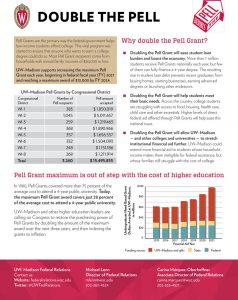Pell Grants are the primary way the federal government helps low-income students afford college. This vital program was started to ensure that anyone who wants to earn a college degree could do so. Most Pell Grant recipients come from households with annual family incomes of $50,000 or less.
UW–Madison supports increasing the maximum Pell Grant each year, beginning in federal fiscal year (FY) 2021 and reaching a maximum award of $13,000 by FY 2024.
- Today, the maximum Pell Grant only covers about one-third of the cost of an average public four-year college—the lowest share of tuition in the program’s history.
- With tuition costs steadily increasing, on top of other necessary expenses, Pell recipients face greater challenges in completing their degree.
- At the current level, students from families earning $30,000 or less need to spend more than 75 percent of their total income to cover the cost of a four-year college, and 50 percent of their annual income for a two-year college.
- Strengthening Pell will not only make college more affordable, but it will also improve outcomes by providing grant recipients more opportunity to focus on school, allowing them to complete their degrees sooner than they may otherwise.
- Helping the most in-need students obtain a college degree will make our nation stronger by making it more equal, and by reinforcing the idea that everyone should have an opportunity to obtain a college education regardless of family income.
Read more about why Congress should double the Pell.
